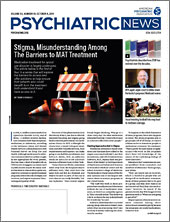An article published in the September issue of Lancet Psychiatry has brought the issue of antidepressant use in youth to the forefront again. A clinical trial led by researchers at Orygen, the National Centre of Excellence in Youth Mental Health in Melbourne, Australia, found that combining cognitive-behavioral therapy (CBT) with fluoxetine was not superior to CBT alone at improving depressive symptoms in teens and young adults with major depression. This lack of effect was particularly noticeable for participants who were younger than 18, noted lead author Christopher Davey, M.B.B.S., Ph.D., the head of Mood Disorders Research at Orygen. For patients aged 18 and over, there was some indication that a combined approach was more effective than CBT alone, especially if the patients had comorbid anxiety symptoms.
The Youth Depression Alleviation–Combined Treatment (YoDA-C) study involved 153 participants aged 15 to 25 years with moderate-to-severe major depression (score of 20 or higher on the Montgomery-Åsberg Depression Rating Scale, or MADRS). All participants received weekly, 50-minute CBT sessions and either daily fluoxetine (up to 40 mg/day) or placebo pills for 12 weeks. The researchers evaluated the participants’ depressive and anxiety symptoms, social functioning, quality of life, and suicidal thoughts every four weeks.
After 12 weeks, there was no statistical difference between the two study groups in depression symptom improvement; MADRS scores decreased by 15.1 points among patients receiving CBT plus fluoxetine and 13.7 points among patients receiving CBT plus placebo. The rates of remission (achieving a MADRS score of 7 or less) were similar in the groups: 24% of patients in the CBT plus fluoxetine group achieved remission, and 19% patients in the CBT plus placebo group achieved remission. Likewise, secondary measures such as improvements in self-reported depressive symptoms, social functioning, and overall quality of life were similar between the two treatment groups.
The one exception was anxiety, as measured by the Generalized Anxiety Disorder 7-item scale (GAD-7). GAD-7 scores decreased by 5.3 points in the fluoxetine group compared with 3.2 points in the placebo group, which was a statistically significant difference.
In looking at different age groups, the researchers found that participants aged 18 and older generally showed stronger responses to fluoxetine than those under 18. Though MADRS scores remained similar, older participants taking fluoxetine had statistically significant improvements in all the secondary measures (anxiety, self-reporteD depressive symptoms, social functioning, and quality of life) relative to placebo. Participants under 18 did not show significant improvements in any of these assessments.
The lack of any benefit of fluoxetine treatment for participants under age 18 is noteworthy since it stands in contrast to the findings of the Treatment for Adolescents With Depression Study (TADS)—a large U.S. clinical trial conducted between 2000 and 2003 across 13 medical centers. This study found that combining CBT with fluoxetine led to greater improvements in depressive symptoms in adolescents up to age 17 compared with CBT alone.
These two studies featured one critical difference: The use of a placebo pill in the comparison group; YoDA-C included one, TADS did not.
While the use of a placebo pill helps to remove potential bias from both the patient and investigator perspectives, “[b]ecause of the high placebo effect seen in youth depression [studies], one cannot assume that CBT plus placebo has the same clinical effect as CBT alone,” Benedetto Vitiello, M.D., a professor of psychiatry at the University of Turin, wrote in an accompanying Lancet editorial.
Vitiello added that much of the design of YoDA-C was intended to make it applicable to the real world: The participants included both teens and young adults, they were referred from local clinics across Melbourne, and there were minimal exclusion criteria (even youth with suicidal thoughts were included in this trial). But the inclusion of placebo pills somewhat undermines this goal of practicality, since doctors cannot ethically give a patient placebo pills in practice.
“These reported differences highlight the importance of nonspecific treatment factors that may influence a patient’s response to medicine,” said Joe Kossowsky, Ph.D., a psychologist and instructor of medicine at Boston Children’s Hospital, who has extensively studied placebo effects. Nonspecific factors include the hopes and expectations of patients when given a pill, as well as the therapeutic bond a patient develops with his or her doctor or therapist, Kossowsky said. Doctors therefore should not underestimate the impact they can have when prescribing an antidepressant.
Together, the results of both TADS and YoDA-C suggest that adding an antidepressant to CBT could improve symptoms, though it may be largely driven by nonspecific factors. The debate then becomes whether these improvements are worth the potential risks of using an antidepressant, which in youth include the black-box warning about potential suicidal ideation. Interestingly, there were fewer suicide attempts in the CBT plus fluoxetine group relative to the placebo group in the YoDA-C study, but participants in the fluoxetine group reported twice as many instances of nonsuicidal self-harm. In both instances, the total number of events was small and not statistically different.
YoDA-C was funded by a grant from the Australian National Health and Medical Research Council. ■
“The Addition of Fluoxetine to Cognitive Behavioural Therapy for Youth Depression (YoDA-C): A Randomised, Double-Blind, Placebo-Controlled, Multicentre Clinical Trial” is posted
here. The accompanying editorial, “Youth Depression: Are Two Treatments Better Than One?,” is posted
here. “The Treatment for Adolescents With Depression Study (TADS): Outcomes Over 1 Year of Naturalistic Follow-Up” is posted
here.
